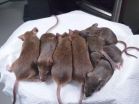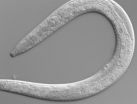(Press-News.org) Using the technique that created Dolly the sheep, researchers from the RIKEN Center for Developmental Biology in Kobe, Japan have identified a way to produce healthy mouse clones that live a normal lifespan and can be sequentially cloned indefinitely.
Their study is published today in the journal Cell Stem Cell.
In an experiment that started in 2005, the team led by Dr. Teruhiko Wakayama has used a technique called somatic cell nuclear transfer (SNCT) to produce 581 clones of one original 'donor' mouse, through 25 consecutive rounds of cloning.
SNCT is a widely used cloning technique whereby a cell nucleus containing the genetic information of the individual to be cloned is inserted into a living egg that has had its own nucleus removed. It has been used successfully in laboratory animals as well as farm animals.
However, until now, scientists hadn't been able to overcome the limitations of SNCT that resulted in low success rates and restricted the number of times mammals could be recloned. Attempts at recloning cats, pigs and mice more than two to six times had failed.
"One possible explanation for this limit on the number of recloning attempts is an accumulation of genetic or epigenetic abnormalities over successive generations" explains Dr. Wakayama.
To prevent possible epigenetic changes, or modifications to DNA function that do not involve a change in the DNA itself, Wakayama and his team added trichostatin, a histone deacetylase inhibitor, to the cell culture medium. Using this technique, they increased cloning efficiency by up to 6-fold.
By improving each step of the SCNT procedure, they were able to clone the mice repeatedly 25 times without seeing a reduction in the success rate. The 581 healthy mice obtained in this way were all fertile, they gave birth to healthy pups and lived a normal lifespan of about two years, similar to normally conceived mice.
"Our results show that there were no accumulations of epigenetic or genetic abnormalities in the mice, even after repeated cloning," conclude the authors.
Dr. Wakayama adds, "This technique could be very useful for the large-scale production of superior-quality animals, for farming or conservation purposes."
Dr. Wakayama's work made the news in 2008 when his team created clones from the bodies of mice that had been frozen for 16 years, using SNCT.
INFORMATION:
Reference:
Sayaka Wakayama, Takashi Kohda, Haruko Obokata, Mikiko Tokoro, Chong Li, Yukari Terashita, Eiji Mizutani, Van Thuan Nguyen, Satoshi Kishigami, Fumitoshi Ishino and Teruhiko Wakayama "Successful serial cloning in the mouse over multiple generations." Cell Stem Cell, 2013, doi: org/10.1016/j.stem.2013.01.005
About RIKEN
RIKEN is Japan's flagship research institute devoted to basic and applied research. Over 2500 papers by RIKEN researchers are published every year in reputable scientific and technical journals, covering topics ranging across a broad spectrum of disciplines including physics, chemistry, biology, medical science and engineering. RIKEN's advanced research environment and strong emphasis on interdisciplinary collaboration has earned itself an unparalleled reputation for scientific excellence in Japan and around the world.
About the Center for Developmental Biology
The RIKEN Center for Developmental Biology (CDB) was launched in April 2000 to advance research in the fields of animal development and regeneration and contribute to areas of clinical medicine that can benefit from such research. The CDB is dedicated to developing a better understanding of fundamental processes of animal development at the molecular and cell biological level, the more complex phenomena involved in organogenesis as well as the biology of stem cells and regeneration. By elucidating these processes researchers working at CDB hope to improve the effectiveness of regenerative medicine, for the benefit of society.
Japanese researchers succeed in making generations of mouse clones
2013-03-07
ELSE PRESS RELEASES FROM THIS DATE:
High BMI linked to heart attack, stroke in young women
2013-03-07
SAN FRANCISCO (March 7, 2013) —A nationwide study of women in Denmark who are of child-bearing age finds that those who are obese appear to have a much greater risk of heart attack or stroke, according to research being presented at the American College of Cardiology's 62nd Annual Scientific Session.
In fact, women with a high body mass index (BMI)—a measure of the body's fat content—that is indicative of obesity were twice as likely as those of normal weight to suffer a potentially life-threatening heart attack or stroke within just four to five years following childbirth. ...
Duckweed as a cost-competitive raw material for biofuel production
2013-03-07
The search for a less-expensive, sustainable source of biomass, or plant material, for producing gasoline, diesel and jet fuel has led scientists to duckweed, that fast-growing floating plant that turns ponds and lakes green. That's the topic of a report in ACS' journal Industrial & Engineering Chemistry Research.
Christodoulos A. Floudas, Xin Xiao and colleagues explain that duckweed, an aquatic plant that floats on or near the surface of still or slow-moving freshwater, is ideal as a raw material for biofuel production. It grows fast, thrives in wastewater that has ...
First discovery of a natural topological insulator
2013-03-07
In a step toward understanding and exploiting an exotic form of matter that has been sparking excitement for potential applications in a new genre of supercomputers, scientists are reporting the first identification of a naturally occurring "topological insulator" (TI). Their report on discovery of the material, retrieved from an abandoned gold mine in the Czech Republic, appears in the ACS journal Nano Letters.
Pascal Gehring and colleagues point out that synthetic TIs, discovered only a decade ago, are regarded as a new horizon in materials science. Unlike conventional ...
Report offers an in-depth examination of health centers' role in family planning
2013-03-07
WASHINGTON and NEW YORK—A report released today by the George Washington University School of Public Health and Health Services (SPHHS) and the RCHN Community Health Foundation offers the first-ever in-depth examination of health centers' role in access to family planning. The report finds that virtually all health centers furnish family planning services to some extent but for both financial and non-financial reasons, only 1 in 5 is able to offer access to the full range of contraceptive services.
The report offers a series of recommendations to strengthen performance, ...
Test-taking may improve learning in people of all ages
2013-03-07
WASHINGTON – Older adults who haven't been in school for a while are as capable of learning from tests as younger adults and college students, according to new research published by the American Psychological Association.
No matter their age or if they work or go to college full time, people appear to learn more when tested on material, rather than simply rereading or restudying information, according to research published online in the APA journal Psychology and Aging.
"The use of testing as a way to learn new information has been thoroughly examined in young students. ...
New gender benchmarking study: Brazil succeeding in providing a positive STI environment for women
2013-03-07
São Paolo, March 7, 2013 – In the first gender benchmarking study of its kind, researchers have found that numbers of women in the science, technology and innovation fields are alarmingly low in the world's leading economies, and are actually on the decline in many, including the United States. Results from Brazil show that despite women having a strong representation in parts of the science, technology and innovation sector, and a slight increase in engineering, physics and computer science, overall numbers are on the decline.
Brazil ranks the highest in this study ...
Lizards facing mass extinction
2013-03-07
Climate change could lead to dozens of species of lizards becoming extinct within the next 50 years, according to new research published today.
Globally it has been observed that lizards with viviparous reproduction (retention of embryos within the mother's body) are being threatened by changing weather patterns. A new study suggests that the evolution of this mode of reproduction, which is thought to be a key successful adaptation, could, in fact, be the species' downfall under global warming.
Researchers from the University of Exeter and the University of Lincoln ...
Penn researchers find molecular key to exhaustion following sleep deprivation
2013-03-07
PHILADELPHIA – It happens to everyone: You stay up late one night to finish an assignment, and the next day, you're exhausted. Humans aren't unique in that; all animals need sleep, and if they don't get it, they must make it up.
The biological term for that pay-the-piper behavior is "sleep homeostasis," and now, thanks to a research team at the Perelman School of Medicine, University of Pennsylvania, one of the molecular players in this process has been identified – at least in nematode round worms.
David Raizen, MD, PhD, assistant professor of Neurology, and his colleagues ...
Advance in re-engineering photosynthesis to make drugs, compounds or ingredients
2013-03-07
Scientists are reporting an advance in re-engineering photosynthesis to transform plants into bio-factories that manufacture high-value ingredients for medicines, fabrics, fuels and other products. They report on the research in the journal ACS Synthetic Biology.
Poul Erik Jensen and colleagues explain that photosynthesis does more than transform carbon dioxide and water into sugar and oxygen and generate energy.
That process also produces a wealth of natural chemical compounds, many of which have potential uses in medicines and other commercial products. However, evolution ...
Exercise shields children from stress
2013-03-07
Chevy Chase, MD ––Exercise may play a key role in helping children cope with stressful situations, according to a recent study accepted for publication in The Endocrine Society's Journal of Clinical Endocrinology & Metabolism (JCEM).
When they are exposed to everyday stressors, the study found sedentary children had surges of cortisol – a hormone linked to stress. The most active children had little or no increase in their cortisol levels in similar situations.
"The findings suggest physical activity plays a role in mental health by buffering children from the effects ...

